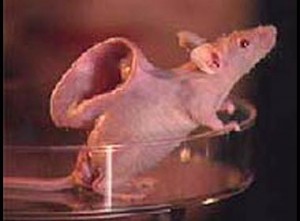Growth Of Ear Cartilage On Mice Using Biodegradable Porous Scaffolds By Dr. Charles Vacanti
 Something that I have been getting into in recent months have been to watch the new TV shows that have come out depicting the fictional literary figure Sherlock Holmes. It has been a great experience comparing the two shows, Elementary and Sherlock, to see how well Sherlock Holmes is portrayed on TV. On the recent episode of Elementary, (Season 2 Episode 17 “Ears to You”) the final conclusion made by Holmes was that the former wife who disappeared managed to grow her a new set of her own ears on her back and have the ears cut off by her new plastic surgeon husband to send to her old husband for ransom money (If you haven’t already seen the show, sorry about the spoiler).
Something that I have been getting into in recent months have been to watch the new TV shows that have come out depicting the fictional literary figure Sherlock Holmes. It has been a great experience comparing the two shows, Elementary and Sherlock, to see how well Sherlock Holmes is portrayed on TV. On the recent episode of Elementary, (Season 2 Episode 17 “Ears to You”) the final conclusion made by Holmes was that the former wife who disappeared managed to grow her a new set of her own ears on her back and have the ears cut off by her new plastic surgeon husband to send to her old husband for ransom money (If you haven’t already seen the show, sorry about the spoiler).
I didn’t focus too much on the show except the part in the end when Holmes mentions this most unique of research done by a certain Dr. Charles Vacanti where he managed to regrow almost a human sized ear on the backs of lab mice. That reminded me of this article I found which showed that a 3-dimensional growth plate like material was formed through. Based on what I’ve read about how the process is done, the steps are the following….
- Find the raw material to make the scaffold. Often the scaffold is made from alginates and/or hydrogel. The scaffold is known by other names as well, like synthetic biodegradable polymer substrates.
- Get the biodegradable porous scaffold molded/buffed/grinded into the shape and size that you want.
- Implant some chondrocytes and/or the MSCs into the scaffolds thoroully so that the entire scaffold is loaded in all the porous holes with the cells.
- Implant with the cells (whether chondrocyte, osteoblasts, or MSCs) some type of growth factor, like a peptide.amino acid/unique protein type, BMP (2, 6, 7, and/or 9), GDF (5 or 9), or TGF-Beta (1,2, and/or 3)
- Place the scaffold with the cells and growth factor into the space/position/cavity in the area of the body as you desire.
- Over time, while the scaffold dissolves and gets absorbed by the body, the cells multiply and take over, turning into the type of tissue that is usually made by the excretion/waste of the cells.
In the case of the lab rats, the cartilage formed from the chondrocytes embedded led to the formation of the ears, which are fibrocartilage in nature. For this particular experiment, the ear lobes were not functional, since there was no inner ear canal, there was no connection of the cartilage to the nerve cells in the periphery, and there was probably very little vascularization into the fibrocartilage. Those the the technical difficulties that Vacanti experienced. However, the idea is definitely interesting and I think those technical difficulties will be easily removed with some slight alterations in the overall tissue engineering process.
However the proof of concept and ideas is valid. That is what excited me. That was also why I started to google the term “biodegradable scaffold cartilage” into Google and Google Scholar and Google Patent to see what turns up. It is most likely that I will be more focused on disecting whatever unique patents and studies I find from this specific search term into Google.
I am almost positive that within 6 months to 1 year, at least I will no longer be writing non-scientific posts. I want to focus exclusively on looking at tissue engineering, tissue regeneration, and stem cell differentiation and stimulations exclusively. That is the area which I think has the most potential.

Hi
I am really interested to know how long we should have this thecnology available for eat reconstruction or repair.